2017 Ford Fusion Sport
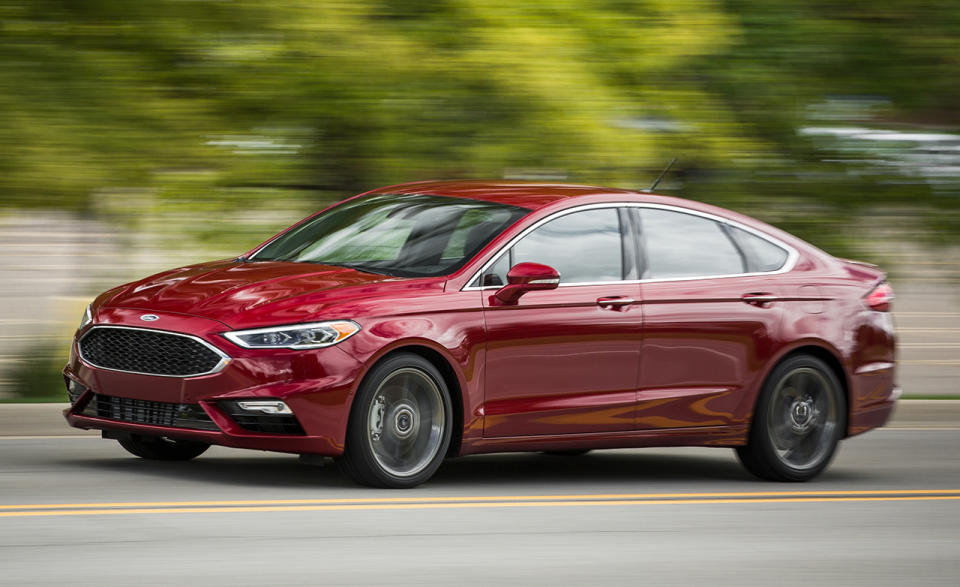
Good news: There’s once again a V-6 engine option for the Ford Fusion after a few years during which Dearborn’s mainstream family sedan offered only four-bangers. Better news: It’s a twin-turbocharged 2.7-liter EcoBoost V-6 making 325 horsepower, an engine we’ve seen before in the F-150 pickup and the Edge crossover. In the Fusion, it appears only under the hood of the Sport, which joins the luxury-focused Platinum as new models in the revised-for-2017 lineup.
Dedicated Ford watchers will recognize this as the return of the Fusion Sport introduced for 2010 and dropped when the car was redesigned for 2013. The mid-term refresh for ’17 brings some amendments—not necessarily improvements to our eye—to the exterior styling, an upgraded interior, and, most appealing, the Sport model tested here.
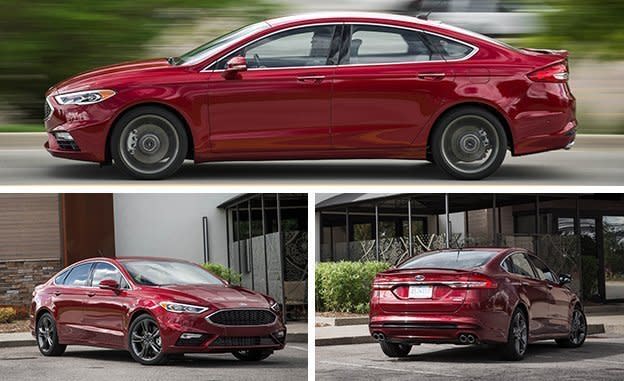
Muscle Machine
The original 2010 Fusion Sport used a naturally aspirated 3.5-liter V-6 making 263 horsepower, roughly equal to what you’d find in the V-6s then available in the Toyota Camry and the Honda Accord, two cars Ford seems to chase perpetually for sales honors in the category. The V-6s account for only incremental numbers for all of these makers, but every buyer counts when you’re vying for the sales crown.
The EcoBoost gives Ford clear bragging rights as the first modern family sedan to bust through the 300-hp barrier, and it outmuscles a lot of would-be sports sedans in the near-luxury arena, too. There’s a lot of grunt on tap—too much, really—for a front-wheel-drive vehicle (see our review of the front-drive Lincoln MKX with this engine). Hence the Fusion Sport’s standard all-wheel-drive system, which operates in front-drive mode until it detects any wheel slip. And it’s pretty easy to induce that condition with 380 lb-ft of torque. If you’re willing to switch away from the digital tachometer display (it’s too small anyway) in the instrument panel, there’s a live graphical depiction available to show the torque being shifted to the rear axle in real time. Entertaining, if you’re not too busy going fast to eyeball it. (Pro tip: Check it out during launches on a dirt road.)
Outside, the Sport is denoted by a black mesh grille with a chrome surround, a subtly integrated decklid spoiler, and four exhaust tips. Inside, the Sport has charcoal gray décor with leather, suede, contrast stitching, matte-finished metal, and faux-carbon-fiber accents. Plastics in the upper portion of the cabin are nicely finished, but the lower portions of the dashboard and the door panels look and feel cheaper. You’re supposed to go for the Platinum model or the Lincoln MKZ if you seek plusher environs. And if an EPA city fuel-economy rating of 17 mpg bothers you, go read about the hybrid model.
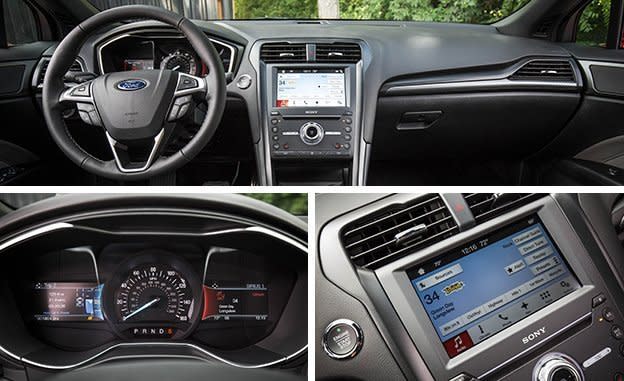
Quick Tricks
The Fusion Sport’s real charm is all beneath those surfaces. The power translates to a dash to 60 mph in 5.1 seconds and through the quarter-mile in 13.7 at 101 mph. This in a segment where 7.0 seconds to 60 mph is considered pretty good and cars that take nearly nine seconds are deemed acceptable. The 278-hp V-6 Honda Accord previously ruled for performance in this bunch, getting to 60 mph in 5.8 seconds and through the quarter-mile in 14.4 at 99. (The soon-to-be-defunct Chrysler 200 did a little better with its 295-hp naturally aspirated V-6.) While the turbocharged Ford’s ample thrust erases worries about merging onto the freeway or passing that landscaper’s dump truck on your favorite two-lane (check those outstanding 30-to-50- and 50-to-70-mph times), there’s other hardware at play to engage the Fusion Sport driver, most notably a computer-controlled adaptive damping system.
Push the S button in the center of the new-for-’17 dial-operated shifter to sharpen the Sport’s reflexes. It tautens the adaptive-damping system, increases steering effort, quickens throttle response, and amps up the artificially enhanced engine sounds. The S button also engages a more aggressive shift program from the six-speed automatic transmission (a heavier-duty unit than in other Fusions) and gives you more control through the standard paddle shifters. It upshifts automatically at 6000 rpm no matter what you do with the paddles, but it will hold gears through corners and rev-match downshifts under braking. None of this changed the measurable on-track performance, but it does make driving the car more entertaining. The dampers, especially, did a great job of supporting aggressive assaults on curving roads while maintaining a ride quality that wouldn’t alarm your grandmother. Adaptive dampers are all but commonplace in pricier, near-luxury sedans and many crossover-utility vehicles but are overdue to trickle into the mass market.
With the standard Goodyear all-season tires, sized 235/40R-19, on the Sport’s specific gray-painted aluminum wheels, lateral acceleration around our skidpad matched the Accord’s 0.84 g, which is good for this class but not particularly sporty. Stopping from 70 mph took an acceptable 178 feet; the optional ($195) summer-only tire chops the braking distance to just 155 feet, and delivers 0.89 g of lateral grip.
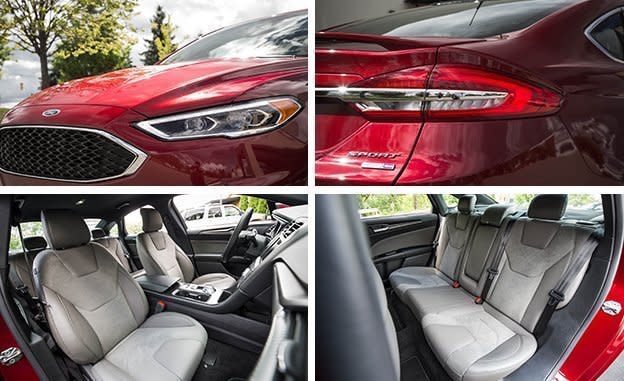
The Limits of Sport
Ford’s commitment here only goes so far, as evidenced by the absence of RS or ST badging; Ford Performance’s handling experts didn’t have their way with the car. Steering feel is lackluster and the brake pedal has a long travel and little feedback. And the car feels every bit as heavy as the 4128 pounds measured on our scales. Ford needs to make haste with its lightweighting research, a field where General Motors is doing much better. All that mass leaves an overall impression that the Fusion Sport amounts to a smaller version of the Taurus SHO, a car whose days are numbered, and even the performance numbers are similar.
When driven aggressively, there are hints of torque steer before the AWD system activates and moments of hesitation where you can feel the car sorting out, just for a moment, which gear to choose and how much steering effort should adjust to conditions. All this keeps it from being a sharp-edged driver’s car, although, on paper, it’s a budget Audi S4. To deliver on that promise, besides putting the car on a diet, would require a less fuel-economy-minded all-wheel-drive system with more rearward bias of torque distribution, and a lot more attention to the niceties of control feel and precision.
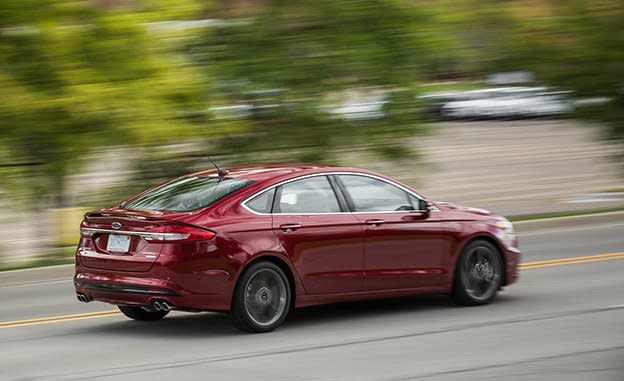
Our example came packed with Ford’s full array of driving assists, including pre-collision warning with pedestrian detection, automated emergency braking, adaptive cruise control, a rearview mirror camera, blind-spot warning, automated guidance into parallel or perpendicular parking spots, lane-keeping assist, and automatic high-beam headlamps. Our car also had voice-activated navigation and an 8.0-inch center touchscreen with swipe and pinch-to-zoom capability, using Ford’s latest Sync 3 system, which is far more user-friendly than before and compatible with Apple CarPlay and Android Auto. All this inflated the bottom line from the $34,450 base price to more than $40K, though it should be noted we’ve seen dealers advertising 2017 Fusion Sports for less than $30,000. Leaving off some of the gizmos might even pare the weight down a bit.
Like the Taurus SHO, the Fusion Sport can be driven gently without betraying the stormier character lurking beneath. And it can be a barrel of fun on the right gravel road, where it becomes a sort of big, comfy rally car, something Tanner Foust could drive when he's ready to move into assisted living. In daily use, the Ford Fusion Sport is a Q-ship that will blend unobtrusively into the flow of traffic until, suddenly, it doesn’t.
Specifications >
VEHICLE TYPE: front-engine, 4-wheel-drive, 5-passenger, 4-door sedan
PRICE AS TESTED: $41,470 (base price: $34,350)
ENGINE TYPE: twin-turbocharged and intercooled DOHC 24-valve V-6, iron and aluminum block and aluminum heads, direct fuel injection
Displacement: 164 cu in, 2694 cc
Power: 325 hp @ 5500 rpm
Torque: 380 lb-ft @ 3500 rpm
TRANSMISSION: 6-speed automatic with manual shifting mode
DIMENSIONS:
Wheelbase: 112.2 in
Length: 191.8 in
Width: 72.9 in Height: 58.2 in
Passenger volume: 106 cu ft
Cargo volume: 16 cu ft
Curb weight: 4128 lb
C/D TEST RESULTS:
Zero to 60 mph: 5.1 sec
Zero to 100 mph: 13.3 sec
Zero to 130 mph: 24.7 sec
Rolling start, 5–60 mph: 5.8 sec
Top gear, 30–50 mph: 2.9 sec
Top gear, 50–70 mph: 3.5 sec
Standing ¼-mile: 13.7 sec @ 101 mph
Top speed (governor limited): 131 mph
Braking, 70–0 mph: 178 ft
Roadholding, 300-ft-dia skidpad*: 0.84 g
FUEL ECONOMY:
EPA city/highway driving: 17/26 mpg
C/D observed: 20 mpg
*Stability-control-inhibited

 Yahoo Autos
Yahoo Autos 